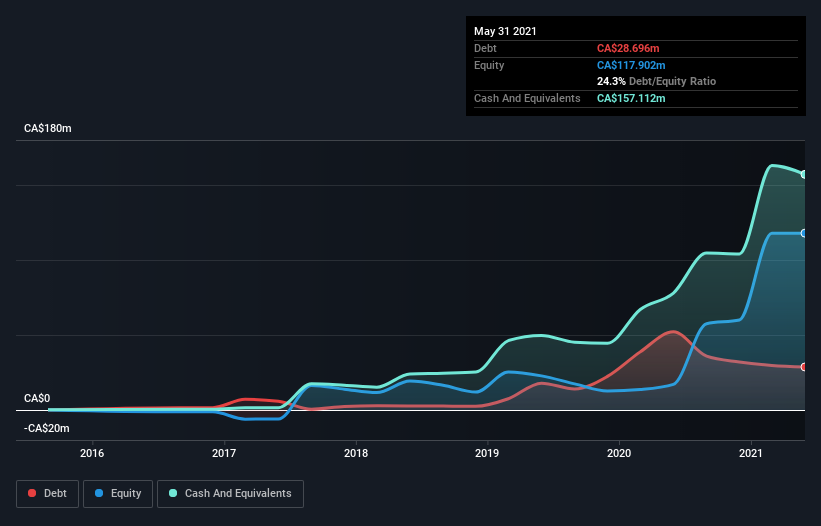- Canada
- /
- Food and Staples Retail
- /
- TSX:FOOD
Goodfood Market (TSE:FOOD) May Not Be Profitable But It Seems To Be Managing Its Debt Just Fine, Anyway

Some say volatility, rather than debt, is the best way to think about risk as an investor, but Warren Buffett famously said that 'Volatility is far from synonymous with risk.' When we think about how risky a company is, we always like to look at its use of debt, since debt overload can lead to ruin. Importantly, Goodfood Market Corp. (TSE:FOOD) does carry debt. But the real question is whether this debt is making the company risky.
When Is Debt Dangerous?
Debt and other liabilities become risky for a business when it cannot easily fulfill those obligations, either with free cash flow or by raising capital at an attractive price. If things get really bad, the lenders can take control of the business. However, a more usual (but still expensive) situation is where a company must dilute shareholders at a cheap share price simply to get debt under control. Having said that, the most common situation is where a company manages its debt reasonably well - and to its own advantage. The first step when considering a company's debt levels is to consider its cash and debt together.
View our latest analysis for Goodfood Market
What Is Goodfood Market's Debt?
As you can see below, Goodfood Market had CA$28.7m of debt at May 2021, down from CA$52.2m a year prior. But it also has CA$157.1m in cash to offset that, meaning it has CA$128.4m net cash.

How Strong Is Goodfood Market's Balance Sheet?
According to the last reported balance sheet, Goodfood Market had liabilities of CA$64.7m due within 12 months, and liabilities of CA$59.9m due beyond 12 months. On the other hand, it had cash of CA$157.1m and CA$5.02m worth of receivables due within a year. So it can boast CA$37.6m more liquid assets than total liabilities.
This surplus suggests that Goodfood Market has a conservative balance sheet, and could probably eliminate its debt without much difficulty. Succinctly put, Goodfood Market boasts net cash, so it's fair to say it does not have a heavy debt load! The balance sheet is clearly the area to focus on when you are analysing debt. But it is future earnings, more than anything, that will determine Goodfood Market's ability to maintain a healthy balance sheet going forward. So if you're focused on the future you can check out this free report showing analyst profit forecasts.
In the last year Goodfood Market wasn't profitable at an EBIT level, but managed to grow its revenue by 55%, to CA$384m. With any luck the company will be able to grow its way to profitability.
So How Risky Is Goodfood Market?
Statistically speaking companies that lose money are riskier than those that make money. And we do note that Goodfood Market had an earnings before interest and tax (EBIT) loss, over the last year. Indeed, in that time it burnt through CA$4.1m of cash and made a loss of CA$7.1m. While this does make the company a bit risky, it's important to remember it has net cash of CA$128.4m. That kitty means the company can keep spending for growth for at least two years, at current rates. With very solid revenue growth in the last year, Goodfood Market may be on a path to profitability. Pre-profit companies are often risky, but they can also offer great rewards. There's no doubt that we learn most about debt from the balance sheet. But ultimately, every company can contain risks that exist outside of the balance sheet. These risks can be hard to spot. Every company has them, and we've spotted 3 warning signs for Goodfood Market you should know about.
Of course, if you're the type of investor who prefers buying stocks without the burden of debt, then don't hesitate to discover our exclusive list of net cash growth stocks, today.
If you're looking to trade Goodfood Market, open an account with the lowest-cost platform trusted by professionals, Interactive Brokers.
With clients in over 200 countries and territories, and access to 160 markets, IBKR lets you trade stocks, options, futures, forex, bonds and funds from a single integrated account.
Enjoy no hidden fees, no account minimums, and FX conversion rates as low as 0.03%, far better than what most brokers offer.
Sponsored ContentNew: Manage All Your Stock Portfolios in One Place
We've created the ultimate portfolio companion for stock investors, and it's free.
• Connect an unlimited number of Portfolios and see your total in one currency
• Be alerted to new Warning Signs or Risks via email or mobile
• Track the Fair Value of your stocks
This article by Simply Wall St is general in nature. We provide commentary based on historical data and analyst forecasts only using an unbiased methodology and our articles are not intended to be financial advice. It does not constitute a recommendation to buy or sell any stock, and does not take account of your objectives, or your financial situation. We aim to bring you long-term focused analysis driven by fundamental data. Note that our analysis may not factor in the latest price-sensitive company announcements or qualitative material. Simply Wall St has no position in any stocks mentioned.
Have feedback on this article? Concerned about the content? Get in touch with us directly. Alternatively, email editorial-team (at) simplywallst.com.
About TSX:FOOD
Goodfood Market
Goodfood Market Corp. delivers fresh meals and add-ons in Canada.
Moderate and slightly overvalued.
Similar Companies
Market Insights
Community Narratives



